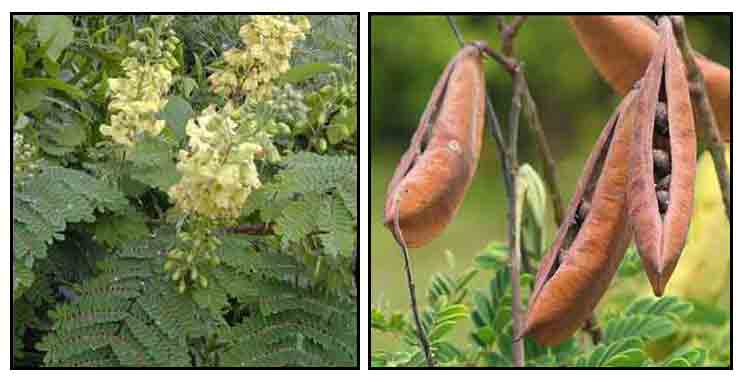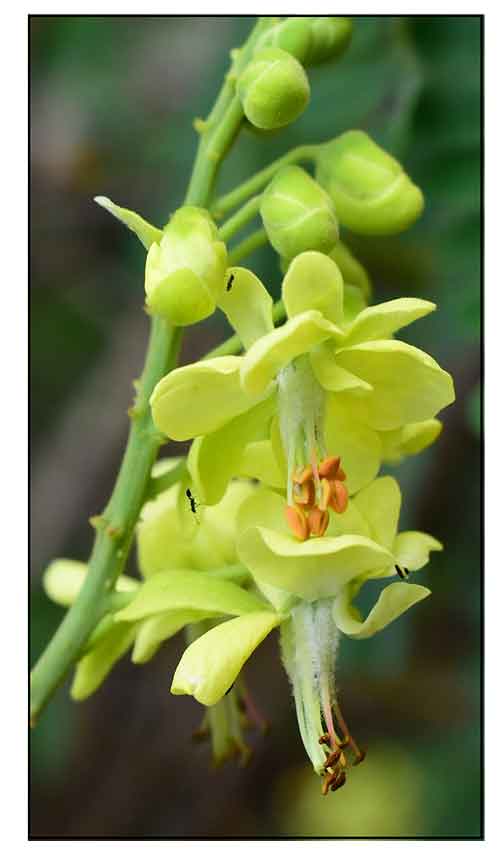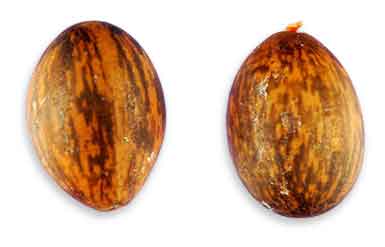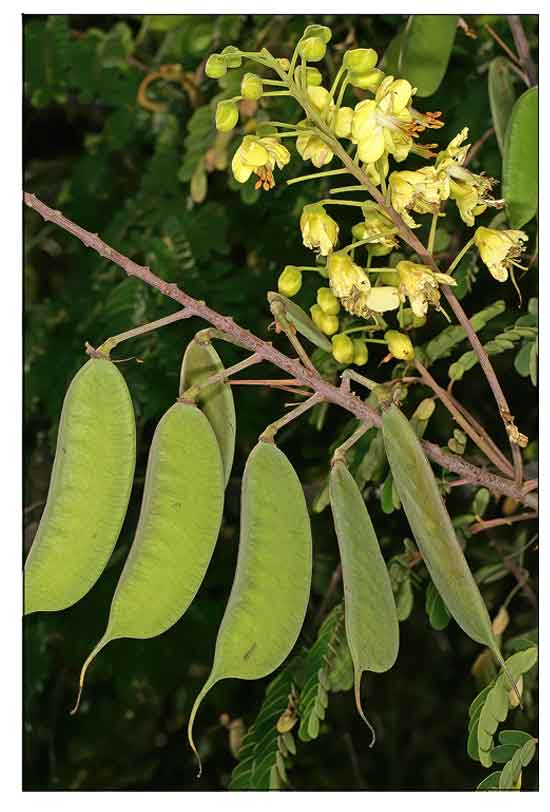  Gen info Gen info
• Biancaea is a genus of flowering plants in the family Fabaceae. The genus incudes seven species,
•
Biancaea decapetala, commonly known as shoofly, Mauritius, Mysore thorn, or cat;s claw, is a tropical tree species in the family Fabaceae. It some places, it has become a seriously problematic species in many places.
Botany
• Puto is a straggling, perennial, woody, thorny, stout climber, vines growing up to 30 feet high. Branches are finely downy, with small yellow prickles. Leaves are two-pinnate, 25 to 40 centimeters long. Leaflets are 10 to 24, opposite, oblong, and 1 to 2.5 centimeters long. Flowers are large, bright chrome-yellow, and on terminal, large, erect racemes. Pod is smooth, nearly flat, obliquely oblong, 5 to 8 centimeters long and about 2.5 centimeters wide, and tipped with persistent style base. There are 4 to 8 oblong, mottled seeds.
• B. decapetala is as a robust, thorny, evergreen shrub 2–4 m (6.6–13.1 ft) high or climber up to 10 m (33 ft) or higher; often forming dense thickets; stems are covered with minute golden hair; the stem thorns are straight to hooked, numerous, and not in regular rows or confined to nodes. The leaves are dark green, paler beneath, not glossy, up to 300 mm (12 in) long; leaflets up to 8 mm (0.31 in) wide. The flowers are pale yellow, in elongated, erect clusters 100–400 mm (3.9–16 in) long. Fruit are brown, woody pods, flattened, unsegmented, smooth, sharply beaked at apex, about 80 mm (3.1 in) long. (18)
Distribution
- Native to the Philippines.
-
In Isabela and the Benguet Provinces in Luzon, in thickets about limestone cliffs and boulder, at altitudes of 1,200 meters.
- Also native to Assam, Bangladesh, China North-Central, China South-Central, China Southeast, East Himalaya, Hainan, India, Japan, Jawa, Korea, Laos, Lesser Sunda Is., Malaya, Myanmar, Nansei-shoto, Nepal, Pakistan, Sri Lanka, Sulawesi, Sumatera, Taiwan, Thailand, Vietnam, West Himalaya, Yemen. (17)
 Constituents Constituents
- Study yielded seven compounds: lupeol acetate, lupeol, oleanoic acid, pentacosanoic acid 2,3-dihydroxypropyl ester, 1-(26-hydroxyhexacosanoyl)-glycerol, stigmasterol, and beta-sitosterol.
- Ethanol extract of stems yielded seven compounds: 6′-hydroxy-3, 4-(1′′-hydroxy-epoxy-propane)-2′, 3′-(1′′β-hydroxy-2′′′-carbonyl-cyclobutane)-1, 1′-diphenyl (1), octacosyl 3, 5-dihydroxycinnamate (2), 2′, 4, 4′-trihydroxychalocone (3), bonducellin (4), 7, 3′, 5′-trihydroxyflavanone (5), daucosterin (6), and β-sitosterol (7).
- Study isolated 14 known compounds viz. andrographolide (1), quercetin (2), ß-sitosterol (3), bergenin (4), rutin (5), emodin (6), betulin (7), stigmasterol (8), baicelein (9), polydatin (10), salicin (11), apigenin (12), epicatechin (13),
and cinnamic acid (14). (see study below) (12)
- Study isolated seven compounds viz. peol acetate (I), lupeol (2), oleanoic acid (3), pentacosanoic acid 2,3-dihydroxypropyl ester (4), 1-(26-hydroxyhexacosanoyl)-glycerol (5), stigmasterol (6), beta-sitosterol (7).
(13)
- GC-MS study of essential oil
yielded 72 components representing 99.6% of total oil identified. Main components were β-caryophyllene (17.2%), followed by β-myrcene (16.6%), (E)-β-ocimene (12.4%), limonene (10.4%), and caryophyllene oxide (9.6%). Monoterpenids and sesquiterpenoids accounted for 90% of the essential oil; both contributed to the characteristic odor of C. decapetala.
(15)
- Study of seeds isolated a new cassane diterpenoid designated phanginin Q (1) together with three known cassane diterpenoids, caesaljapin (2), caesaldekarin A (3), and caesaldekarin B (4).
(16)
 Properties Properties
- Purgative, astringent, anthelmintic , antipyretic, antimalarial.
- Reported as psychoactive and hallucinogenic.
- Studies have shown antioxidant, anti-inflammatory, analgesic, antipyretic, anti-diarrheal, anti-implantation, antiviral, nitric oxide inhibitoryproperties.
Parts used
Leaves, seeds, roots.
 Uses Uses
Folkloric
- Roots are considered purgative.
- In Chamba, the bruised leaves are applied to burns.
- Seeds are considered astringent, antipyretic, anthelmintic, and antimalarial.
- Used for the treatment of ague.
- In China, decoction of flowers used to expel intestinal worms. Plant also used for malaria and skin affections. In excess, use reported to cause idiocy.
- In india, plant decoction used for baths in treatment of jaundice. Leaves are used for burns, biliousness and stomach problems. Also used as laxative, tonic, and antipyretic.
- In Bhandrdara, India, fresh leaves are boiled with tea powder in a cup of goat's milk and taken twice daily for 3-4 days to control gingivitis and pyorrhea. (14)
- In India, seed powder used for malaria. Seed paste used to remove freckles. Root used as purgative. Bark decoction used as abortifacient. Roots, stems, and pods used for pain. Root juice decoction used for sprains and muscular swellings. Leaves used as emmenagogue. Bruised leaves applied to burns. Flower infusion used for bronchitis, asthma, and malarial fevers. Bath decoction used for treatment of jaundice. (20)
- In Ethiopia, roots and leaves used for treatment of "evil eye". (24)
Others
- Tanning: In southern India, bark is used for tanning.
- Magic / Superstition: In Chinese herbal medicine, flowers reported to have magical properties, producing levitation and communication with spirits. Decoction of flowers drunk as tea to communicate with spirits or dispel evil forces.
- Psychoactive: Preparations of crushed and powdered seeds combined with seeds of Hyoscyamus niger (lang-tang) made in incense possess psychoactive properties when burned.
- Agroforestry: Its dense thorny growth habit makes for a livestock excluding barrier. In Nepal, grown as field boundaries. Used for soil stabilization projects. (21)
- Seed oil: Seed from oil used as lubricant and for soap.
- Insecticide: Seeds and roots used as insecticidal.
Studies
• Anti-Implantation: C. sepiaria is one of nine plants in a study that confirmed the plants have anti-implantation effect. (2)
• Antidiarrheal: On 182 plants studied, C. sepiaria was one of 28 flowering plants with antidiarrheal activity. (3)
• Antioxidant: Study of methanol extracts from the wood and pericarp of C. decapetala showed significant concentration and dose-dependent antioxidant activity. Total phenols, flavonoids and total flavonols were higher in the pericarp than the wood. (5)
• Gallic Acid / Radical Scavenging Activity : Study investigated the antioxidant capacities and phenolic contents of gallic acid isolated from Caesalpinia decapetala. The total phenolic content was 4.31%. Isolated Gallic Acid showed significant in vitro free radical scavenging activity. (8)
• Caesaldecan / Cassane Diterpenoid: Study isolated a new cassane diterpenoid, caesaldecan, from the leaves, together with eight known compounds viz. spathulenol, 4,5-epoxy-8(14)-caryophyllene, squalene, lupeol, trans-resveratrol, quercetin, astragalin, and stigmasterol. (9)
• Seed Gum As Drug Release Vehicle: Seed gum isolated from C. pulcherrima kernel powder can be used for controlled release of both water-soluble and water insoluble drugs. (10)
• Antitumor / Antioxidant: Study isolated 14 known compounds. Emodin (6), baicalein (9), and apigenin (12) showed significant antitumor activities against MGC-803 cell lines with IC50 of 15.6, 16.3, and 13.2 µmol/L, respectively. Baicalein (9), epicatechin (13), quercetin (2) and rutin (5) showed significant DPPH scavenging capacities, stronger than ascorbic acid. (see constituents above) (11)
• Analgesic / Anti-Inflammatory / Antipyretic: Study evaluated 70% aqueous methanolic and n-hexane extracts of C. decapetala using Swiss albino mice. Aqueous methanolic extract showed significant (p<0.05) activities in various pain models viz. acetic acid-induced writhing, formalin-induced licking, and hot plate method and significant antipyretic and anti-inflammatory activities more than the n-hexane extract. (12)
• Anti-Inflammatory Via TNF/Akt/NF-kB Pathway: Study evaluated the anti-inflammatory activity of B. decapetala extract (BDE) in vitro and invivo and its possible mechanisms and potential targets. BDE inhibited expression of TNF-α, IL-1ß, IL-6, and relevant proteins, including p-p65, p-Akt, p-IkBα. BDE also inhibited nuclear translocation of NF-kB (p65) and activation of the Akt pathway by SC79. Luciferase reporter gene analysis, DARTS, and SPR experiments showed BDE may bind to TNF-α and inhibit the TNF-α-NF-kB pathway, thereby attenuating inflammation. Results reveal anti-inflammatory effects and BDE mechanisms and provides theoretical basis for further development and utilization of BDE. (19)
• Nitric Oxide Inhibitors / Anti-Inflammatory / Stem Bark: Study of stem bark by anti-inflammatory guided fractionation, isolated 16 compounds. All compounds were assessed for invitro anti-inflammatory activity against lipopolysaccharide (LPS)-induced nitric oxide production in macrophage RAW264.7 cells. Compounds 3-deoxysappanchalcone and sappanchalcone-3'-methylether exhibited most potent inhibitory activity with IC50s of 9.82 and 10.89 µM respectively. Compounds isoliquiritigenin-4-methylether, intricatin, 4,4′-dihydroxy-2-methoxystilbene, dihydrodehydrodiconiferyl alcohol, isolariciresinol, isoliquiritigenin, protocatechuic acid, and nocomtol demonstrated moderate inhibitory effects with IC50 values ranging from 42.51 to 86.13 μM. In silico docking simulations indicated a high correlation between docking score and number of interactions. (22)
• Antiviral Activity / Influenza Virus Infection Inhibition: Study of ethanol extract of Caesalpinia decapetala (EEC) showed inhibitory activity against replication of a panel of influenza A and B viruses both on human pulmonary epithelial A549 and human monocytic U937 cells. EEC administration reduced weight loss and improved survival rate of mice infected with lethal influenza virus. EEC also attenuated lung injury and significantly reduced virus titer. Results showed both invitro and invivo antiviral activity. (23)
• Acute Toxicity Study: In acute toxicity study, administration of a single 2000 mg/kg dose of plant extract to five mice did not reveal signs of toxicity or mortality during the entire observation period. LD50 greater than 2000 mg/kg indicates the plant is relatively safe. (25)
Availability
Wild-crafted.
|

![]()




 Gen info
Gen info
 Properties
Properties
